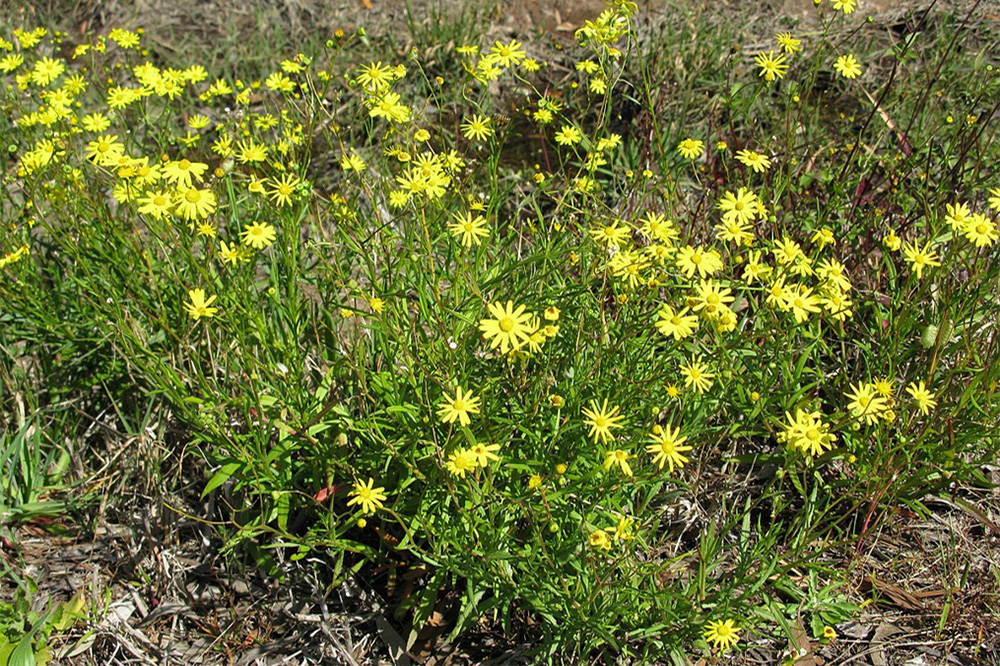Story
Biosecurity alert: Madagascar ragwort
Madagascar ragwort is a farmer’s nightmare, and it is on the move in Northland.
It’s poisonous – and can be fatal – to stock, remaining toxic even in hay or silage, with no treatment available for affected animals. It spreads like wildfire, with adult plants able to produce up to 10,000 easily dispersed seeds per year, and rapid growth meaning it can go from germination to flowering in as little as 6 weeks. It grows in all types of soils but has a competitive advantage in low fertility soils and pasture damaged by drought or overgrazing. And it’s extremely difficult to get rid of once established.
Madagascar ragwort, also known as fireweed overseas, is thought to have arrived in Northland on equipment from Australia about 20 years ago. It is now well established in the Far North, and is continuing to spread, with increasing infestations in Kerikeri and other areas in the mid-north, and reports further south. Its native and invasive range overseas indicate that most of the North Island would be susceptible, and climate modelling suggest significant areas of the South Island would be as well. It looks essentially identical to gravel groundsel, which was introduced in the 1920s and is now widespread, but it is much more invasive in pasture and a much greater threat.
If Madagascar ragwort is not yet on your property, we strongly recommend you keep it out by ensuring contracting equipment is clean before it arrives on farm, and hay and sileage is not contaminated with seed. If you do see a plant or plants on your property, act immediately, and be vigilant and persistent to stop it establishing. Make sure any farm workers or contractors know what it looks like and to report it if they think they have seen it.

Madagascar ragwort.
If you discover a small infestation, pull the plants out and bag them up securely so you don’t risk spreading seeds – carry bags on your bike/tractor so you have them at the ready. To dispose of it, you can either burn the plants (do not burn in domestic fireplaces due to toxicity) or securely dispose of it to landfill. In terms of manual control methods for larger infestations, slashing is not usually effective unless carefully timed and repeated frequently. If you use this method be mindful that slashed plants become more palatable to stock but remain toxic. In addition, pruned plants can become woody and more resistant to herbicides.
Evidence from overseas has shown that good pasture management will help you to limit a Madagascar ragwort infestation. Good dense grass cover reduces germination rates so maintaining healthy pasture, avoiding overstocking, and resting pasture between grazing will make a difference to infestation density.
Mixed grazing is also a management approach used overseas to manage infestation levels. Cattle and horses are extremely susceptible to Madagascar ragwort poisoning, whereas sheep and goats are more tolerant of the toxins. Cattle and horses will graze around the weed if given the choice, but if the infestation is severe or pasture is scarce the risk of ingestion is higher. Sheep and goats can graze in infested pasture for longer, although their milk can be affected.
There is no known single herbicide control method that will control all growth stages of this weed, which makes herbicide control challenging for large scale infestations. However, Farmlands has been working with farmers and contractors in the Far North to trial different methods, and Farmlands’ Technical Field Officer Chris Baker says they have identified a couple of options, depending on your situation and levels of infestation.
“It’s still early days, but for large-scale infestations we’ve seen promising results with a mix of ‘Sprinter 700 DS’, ‘Kamba 750’, and ‘Bonza’ as a wetting agent,” he says.
“If you get the timing right you can achieve excellent control of seedlings and adult plants. However, it won’t control flowering adults, so how you use it is really important to exhaust the seedbank and break the cycle.”
He stresses that it is not a ‘one-size-fits-all’ approach and needs to be undertaken as part of a programme of repeat treatments carefully timed around seasonal germination peaks to maximise effectiveness. He says farmers also need to be mindful about the risk of pasture damage to non-target species and withholding periods.
“This option will damage clover in your pasture, but there are ways to minimise this impact. Alternatively, a mix of ‘Sprinter 700 DS’, ‘Valdo 880WG’, and ‘Bonza’ is another option, but this mix isn’t as reliable at controlling adult plants. I’d advise farmers who are interested to do their homework, talk to an expert about their specific situation, and view these herbicide solutions as part of a broader control programme rather than a ‘silver bullet’”.
Farmlands will be running two field days in early February to share management and control information in more depth.
AgResearch is also looking into agrichemical control options on behalf of Northland Regional Council, to formalise control advice and to identify options for further testing in New Zealand.
Biocontrol is another avenue being pursued. In 2023, Manaaki Whenua Landcare Research was commissioned to undertake a feasibility study for biocontrol for Madagascar ragwort. Unfortunately, this study found that the potential agents that have already been identified and tested in Australia have recently proven to be unsuitable. The next phase is further DNA research and survey work to identify potential new insects and pathogens for testing. Council is in discussions with industry and other regions regarding funding to progress this work.
